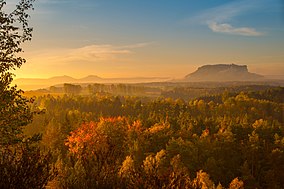Saxon Switzerland National Park
| Saxon Switzerland National Park | |
|---|---|
| Nationalpark Sächsische Schweiz | |
 View of the Lilienstein in Saxon Switzerland | |
| Location | |
| Nearest city | Dresden |
| Coordinates | 50°54′51″N 14°16′42″E / 50.91417°N 14.27833°E |
| Area | 93.5 km² |
| Established | 1990 |
Saxon Switzerland National Park (
The national park adjoins Bohemian Switzerland National Park (Czech: České Švýcarsko) in the Czech Republic.
Geography
Location
The National Park is situated in the centre of a natural area of almost 710 km2 (274 mi2). This region, called
40% of the area of the National Park is covered almost completely by woodland. The status of National Park, which grants the highest natural protection in Germany, was attributed in 1990. The park lies – in two geographically separate areas – within the district of
Landscape
Saxon Switzerland is an intensively fissured and rocky
Western region
This region includes the
Eastern region
The eastern region includes the area of the
Tourism and recreation

The definition of national Park is, in some cases, in conflict with tourism and recreation. One objective is to raise the inviolate area to 75%, which means limiting the areas of hiking and climbing.
The development of the network of paths in today's national park took place in the first half of the 19th century and completed at the beginning of the 20th century. The historical route guides illustrate it thoroughly (e.g., Meinhold's route guide). The first hiking restrictions were declared as early as in the 1980s (Thorwalder Wände ridge path). Today the National Park has a marked network of 400 km of hiking trails, numerous mountain restaurants, and some 50 km of cycling trails. It is compulsory to use marked routes in the National Park. Though visitors may use all paths outside the core zone, only marked trails are allowed within the core zone.
The painter's way
The 'Painters' Trail' (Malersweg in German) is a 116 km long hiking trail that starts in the city of Pirna and follows the Elbe eastwards until Schmilka, where it crosses the river loops back to Pirna. It represents only a small part of the park area, but due to its beauty and being a well-developed trail, most visitors prefer it for hiking. The Bastei bridge is the first view of the Valley for many visitors and is extensively photographed and documented.
Rock climbing
The peculiar form of the sandstone cliffs in Saxon Switzerland national park attracts crowds of climbers every year. However, since these cliffs are sandstone, it is important to treat them with caution.

The following rules, introduced at the beginning of the 20th century, are in place to preserve the national park sandstone:
- Visitors are not permitted to climb when the rock is wet or crumbling.
- Ropes are only allowed for safety purposes and abseiling.
- Metal safety equipment, such as chock-stones and solid rings, are forbidden.
- Visitors are not allowed to use chemical aids such as magnesia.
- The rock surface must not be modified – except to attach retaining rings on first ascents.
Information posts
- National Park Headquarters
- National Park Centre in Bad Schandau
- National Park Office in Bad Schandau
- Information posts
- Schweizerhaus on the Bastei
- Amselfallmountain hut
- Log cabin on the Brand
- Eishaus on the Großer Winterberg
- Armoury in the Großer Zschand
- Haus Beize and Waldhusche in Hinterhermsdorf
- Schweizerhaus on the
Points of interest

- Pflanzengarten Bad Schandau, a regional botanical garden
- Bastei Bridge

